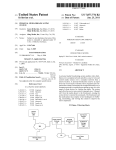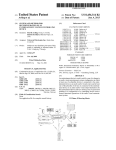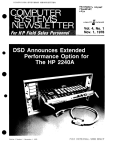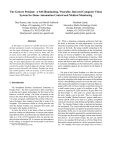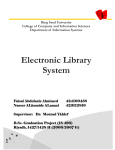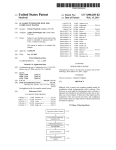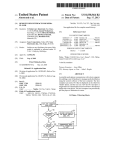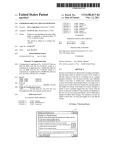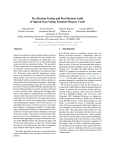Download Media streaming device with gateway functionality
Transcript
US008477793B2 (12) Ulllted States Patent (10) Patent N0.: Tarra et al. (54) (45) Date of Patent: MEDIA STREAMING DEVICE WITH GATEWAY FUNCTIONALITY . (75) Inventors: Raglhuveer Tarlra, Cupertlno, CA (US); 5,493,638 A 2/1996 8/1997 Carles 9/1997 Helms 10/1997 Hendricks et a1. (Continued) Subject to any disclaimer, the term of this CN patent is extended or adjusted under 35 DE FOREIGN PATENT DOCUMENTS 1464685 12/2003 4407319 A1 9/ 1994 U.S.C. 154(b) by 385 days. (Continued) (21) Appl. No.2 12/237,103 . (22) OTHER PUBLICATIONS _ USPTO, Final Of?ce Action, mailed Nov. 6, 2009; US. Appl. No. Flled' sep‘ 24’ 2008 (65) 09/809,868, 1116a Mar. 15, 2001. Prior Publication Data US 2009/0080448 A1 (Continued) Mar. 26, 2009 Primary Examiner * Marsha D Banks Harold Assistant Examiner * Matthew Campbell Related US. Application Data (60) Provisional application No. 60/975,239, ?led on Sep. gé) Attorney’ Agent’ or Flrm i Ingrassla Flsher & Lorenz’ 26, 2007. (51) Int- Cl‘ H04L 12/56 (52) H00 er et a1. 2/1997 vishlzvana?l et a1‘ 5,661,516 A (73) Assignee: Sling Media, Inc., Foster City, CA (U S) Notice: 8/1993 Mills et a1. 1/1995 Degen et a1. 7/1995 Dinwiddie, Jr. et a1. 5,666,426 A 5,682,195 A Bangalore (IN) Jul. 2, 2013 5,237,648 A 5,386,493 A 5,434,590 A 5,602,589 A Parlmal BaJPals Bangalore (IN); Sharath Hariharpur Satheesh, (*) US 8,477,793 B2 H04L 29/02 us CL ' ' (57) ABSTRACT Various methods and devices provide place shifting of a (2006.01) (2006.01) media stream to a remote device While also providing net Work functionality for a local area network (LAN) and/or a USPC ......................................... .. 370/401; 370/252 (58) Field of Classi?cation Search Wide area network (WAN) The gateway includes a media interface for receiving audio/visual (A/V) signals from the USPC ______ __ 370/252, 401, 412; 707/1041; 709/222; media source, as Well as interfaces to the LAN and/or the 711/151 See application ?le for Complete Search history WAN. A media streaming module receives the A/V signals from the media interface and processes the received A/V signals to thereby create the media stream. A modern module receives the media stream from the media streaming module (56) References Cited via a dedicated connection, netWork sWitch and/ or other con nection, and transmits the media stream to the remote device via at least one of the ?rst and second netWork interfaces. U.S. PATENT DOCUMENTS 3,416,043 A 12/1968 Jorgensen 4,254,303 A 5,161,021 A 3/1981 Takizawa 11/1992 Tsai 16 Claims, 2 Drawing Sheets LAN Local Client Device 140A Local Client Device 1405 Gateway __ Riff” M m I Source . Loca‘ Client Streaming Device Device 1400 E Remote Client Device HQ . HO —“ US 8,477,793 B2 Page 3 2002/0138843 2002/0143973 2002/0147634 2002/0147687 2002/0167458 2002/0188818 2002/0191575 2003/0001880 2003/0028873 2003/0065915 2003/0093260 2003/0095791 2003/0115167 2003/0159143 2003/0187657 2003/0192054 2003/0208612 2003/0231621 2004/0003406 2004/0052216 2004/0068334 2004/0083301 2004/0100486 2004/0103340 2004/0139047 2004/0162845 2004/0162903 2004/0172410 2004/0205830 2004/ 0212640 2004/0216173 2004/0236844 2004/0255249 2005/0021398 2005/0027821 2005/0038981 2005/0044058 2005/0050462 2005/0053356 2005/0055595 2005/0060759 2005/0097542 2005/0114852 2005/0132351 2005/0138560 2005/0198584 2005/ 0204046 2005/0216851 2005/0227621 2005/0229118 2005/0237434 2005/0246369 2005/0251833 2005/0283791 2005/0288999 2006/0011371 2006/0031381 2006/0050970 2006/0051055 2006/0095401 2006/0095471 2006/0095472 2006/0095942 2006/0095943 2006/0107226 2006/0117371 2006/0146174 2006/0280157 2007/0003224 2007/0005783 2007/0022328 2007/0074115 2007/0076604 2007/0168543 2007/0180485 2007/0198532 2007/0234213 2007/0286596 2008/0019276 A1 A1 A1 A1 A1 A1 A1 A1 A1 A1 A1 A1 A1 A1 A1 A1 A1 A1 A1 A1 A1 A1 A1 A1 A1 A1 A1 A1 A1 A1 A1 A1 A1 A1 A1 A1 A1 A1 A1 A1 A1 A1 A1 A1 A1 A1 A1 A1 A1 A1 A1 A1 A1 A1 A1 A1 A1 A1 A1 A1 A1 A1 A1 A1 A1 A1 A1 A1 A1 A1 A1 A1 A1 A1 A1 A1 A1 A1 A1 9/2002 10/2002 10/2002 10/2002 11/2002 12/2002 12/2002 1/2003 2/2003 4/2003 5/2003 5/2003 6/2003 8/2003 10/2003 10/2003 11/2003 12/2003 1/2004 3/2004 4/2004 4/2004 5/2004 5/2004 7/2004 8/2004 8/2004 9/2004 10/2004 10/2004 10/2004 11/2004 12/2004 1/2005 2/2005 2/2005 2/2005 3/2005 3/2005 3/2005 3/2005 5/2005 5/2005 6/2005 6/2005 9/2005 9/2005 9/2005 10/2005 10/2005 10/2005 11/2005 11/2005 12/2005 12/2005 1/2006 2/2006 3/2006 3/2006 5/2006 5/2006 5/2006 5/2006 5/2006 5/2006 6/2006 7/2006 12/2006 1/2007 1/2007 1/2007 3/2007 4/2007 7/2007 8/2007 8/2007 10/2007 12/2007 1/2008 Samaan et al. 2008/0037573 A1* 2/2008 Cohen ......................... .. 370/412 Price Jacoby et al. Breiter et al. Baudisch et al. 2008/0059533 2008/0134267 2008/0195744 2008/0199150 3/2008 6/2008 8/2008 8/2008 Krikorian Moghe et al. A1 A1 A1 A1 Bowra et al. Candelore Nimura et al. 2008/0294759 A1* 11/2008 Biswas et al. ............... .. 709/222 Kalavade et al. HoltZ et al. Lemmons Yu et al. 2008/ 0307456 2008/0307462 2008/ 0307463 2009/0074380 12/2008 12/2008 12/2008 3/2009 Beetcher et al. Beetcher et al. Beetcher et al. Boston et al. Dagtas et al. 2009/0199248 A1 8/2009 Ngo et al. Barton et al. Sharif et al. 2010/0100915 A1 4/2010 Krikorian et al. Chan Erllm et a1~ Buk? et a1~ Ham? et a1‘ A1 A1 A1 A1 FOREIGN PATENT DOCUMENTS 0838945 A 4/1998 1077407 A1 2/2001 1443766 A2 8/2004 EP EP EP GPbbI fit a1~ EP Blllmaler EP R01! ~~~~~~~~~~~~~~~~~~~~~~~~~~~~ ~~ 370/252 KR 19990082855 A 1691550 A Tsal et 31' KR 20010211410 A Mums? et 31' WO 0133839 A1 Flamlm et a1~ WO 0147248 A2 6/2001 sundaréson et a1~ R?chstelner et a1~ WO WO 0193161 A1 03026232 A1 12/2001 3/2003 Klm et 31' Oh_ __ WO WO 03052552 A2 03098897 A 6/2003 11/2003 shlmollma et a1~ Kaneko WO WO 2004032511 A1 2005050898 A2 4/2004 6/2005 Mann et a1‘ _ WO 2006064454 A1 6/2006 HOIOSZOWSkI et a1~ Kocherlakota Chang et a1~ Mccleskey et a1~ Alexander et a1~ Connor et 31' Matthews et al. Whittle et a1~ Mate et al. W0 W0 W0 W0 W0 WO 2006074110 2007027891 2007051156 2007141555 2007149466 2008024723 Frazer et al. Rowe et 31' USPTO, Final Of?ce Action mailed Nov. 12, 2009; U.S. Appl. No. 11/620,707, ?led Jan. 7, 2007. (Lin et a1 Randall et'aL USPTO, Non-Final Of?ce Action mailed Nov. 23, 2009, U.S. Appl. No. 11/683,862, ?led Mar. 8,2007. Lee et a1‘ Matthews et al, Watanabe Hull et al. USPTO, Non-Final Of?ce Action mailed Oct. 1, 2009; U.S. Appl. No. 11/778,287, ?led Jul. 16,2007. USPTO Final Of?ce Action mailed Dec. 30, 2009; U.S. Appl. No. 11/147,664, ?led Jun. 7, 2005. Katoh European Patent Of?ce, European Search Report, mailed Sep. 28, 1830558 A1 A A2 A2 A2 A2 A 8/2006 9/2007 11/1999 8/2001 5/2001 7/2006 3/2007 5/2007 12/2007 12/2007 2/2008 OTHER PUBLICATIONS Chiu er a1, 2009 for European Application No. EP 06 78 6175. Tak€1t°n et a1~ ~~~~~~~~~~~~~ ~~ 725/100 International Search Report for PCT/US2008/069914 mailed Dec. Ore1Zy et al. SChedlVY 19, 2008‘ PCT Partial International soaion, PCT?JS2009/054893, mailed Dec. McCarthy et al. Lerner et al. 23 2009 ’ ,' . . Fahey Van Luijt et a1‘ Newton s Telecom D1ct1onary, 21st ed., Mar. 2005. DitZe M. et all “Resource Adaptation for Audio-Visual Devices in the Gunatilake UPnP QoS Architecture,” Advanced Networking and Applications, Ohkawa Krikorian et al. Krikorian et al. 2006; AINA, 2006; 20% H International conference on Vienna, Aus tria Apr. 18-20, 2006. Joonbok, Lee et al. “Compressed High De?nition Television Kfikofian et 31~ ~~~~~~~~ ~~ 707/1041 (HDTV) Over IPv6,”Applications andthe Internet Workshops, 2006; Van B?fk Saint Workshops, 2006; International Symposium, Phoenix, AZ, Demlrcln et a1~ USA, Jan. 23-27, 2006. xgi??‘izs et 31' Hagigno Karaoguz et a1‘ Lowekamp, B. et al. “A Hierarchy of Network Performance Charac teristics for Grid Applications and Services,” GGF Network Mea Krikorian et a1‘ Saint_Hi11aire et 31‘ Meyer, Derrick “MyReplayTVTM Creates First-Ever Online Portal to Personal Ti! Service; GivesViewers Whole New Way to Interact With Tana et a1‘ Patten et a1‘ Programing,” http://web.archive.org/web/20000815052751/http:// www.myreplaytv.com/, Aug. 15, 2000. surements Working Group, pp. 1-29, May 24, 2004. Litwack Sling Media “Sling Media Unveils Top-of-Line SlingboX PRO-HD” Krikorian et 31, Dua [online], Jan. 4, 2008, XP002560049; retrieved from the Internet: URL:www.slingmedia.com/get/pr-slingboX-pro-hd.html; retrieved Kfikofian et On Oct. 12, 2009. Krikorian et al. Srisuresh, P. et al. “Traditional IP Network Address Translator (Tra Lonn ditional NAT),” Network Working Group, The Internet Society, Jan. Takatsuji et al. 2001. US 8,477,793 B2 Page 4 Lucas, Brian et al. “Systems and Methods for Establishing Connec tions Between Devices Communicating Over a Network,” U.S. Appl. No. 12/426,103, ?led Apr. 17, 2009. Thiyagarajan, Venkatesan et al. “Always-On-Top Media Player Launched From a Web Browser,” U.S. Appl. No. 12/617,271, ?led Nov. 12, 2009. Paul, John Michael et al. “Systems and Methods for Delivering Messages Over a Network,” U.S. Appl. No. 12/619,192, ?led Nov. 16, 2009. Rao, Padmanabha R. et al. “Methods and Apparatus for Establishing Network Connections Using an Inter-Mediating Device,” U.S. Appl. No. 12/642,368, ?led Dec. 18, 2009. Dham, Vikram et al. “Systems and Methods for Establishing Network Connections Using Local Mediation Services,” US. Appl. No. 12/644,918, ?led Dec. 22, 2009. Paul, John et al. “Systems and Methods for Remotely Controlling Media Server Via a Network,” U.S. Appl. No. 12/645,870, ?led Dec. 23, 2009. Bajpal, Parimal et al. “Method and Node for Transmitting Data Over a Communication Network using Negative Ackhowledgement,” U.S. Appl. No. 12/404,920, ?led Mar. 16, 2009. Bajpal, Parimal et al. “Method and Note for Employing Network connections Over a Connectinoless Transport Layer Protocol,” U.S. Appl. No. 12/405,062, ?led Mar. 16, 2009. Asnis, Ilya et al. “Mediated Network address Translation Traversal” U.S. Appl. No. 12/405,039, ?led Mar. 16,2009. China State Intellectual Property Of?ce “First Of?ce Action,” issued Jan. 8, 2010, for Application No. 200810126554.0. USPTO Final Of?ce action mailed Jan. 25, 2010; US. Appl. No. 11/734,277, ?led Apr. 12,2007. Australian Government “Of?ce Action,” Australian Patent Applica tion No. 2006240518, mailed Nov. 12, 2009. Jain, Vikal Kumar “Systems and Methods for Coordinating Data Communication Between Two Device,” U.S. Appl. No. 12/699,280, International Search Report for International Application No. PCT/ US2007/076337, mailed Oct. 20, 2008. International Search Report and Written Opinion for International Application No. PCT/US2006/025912, mailed Jul. 17, 2008. International Search Report for International Application No. PCT/ US2008/059613, mailed Jul. 21, 2008. International Search Report and Written Opinion for International Application No. PCT/US2008/080910, mailed Feb. 16, 2009. Wikipedia “SlingboX” [Online], Oct. 21, 2007, XP002512399; retrieved from the Internet: <URL:http://en.wikipedia.org/w/indeX. php?title:SlingboX&oldid:166080570>; retrieved on Jan. 28, 2009. Capable Networks LLC “Keyspan Remote ControliControlling Your Computer With a Remote” [Online], Feb. 21, 2006, XP002512495; retrieved from the Internet: <URL:http://www. slingcommunity.com/article/1 1791/Keyspan-Remote-Control-Controlling-Your-Computer-With-a-Remote/? highlight:remote+control>; retrieved on Jan. 28, 2009. Wikipedia “LocationFree Player” [Online], Sep. 22, 2007, XP002512400; retrieved from the Internet: <URL:http://en. wikipedia.org/w/indeX .php?title:LocationFreeiPlayer& oldid:159683564>; retrieved on Jan. 28, 2009. Sling Media Inc. “SlingboX User Guide” [Online] 2006, XP002512553; retrieved from the Internet: <URL:http://www. slingmedia.hk/attach/en-USiSlingboXiUseriGuideiv1 .2 .pdf>; retrieved on Jan. 29, 2009. Sony Corporation “LocationFree TV” [Online], 2004, SP002512410; retrieved from the Internet: <URL:http://www.docs. sony.com/release/LFX1iX5revision.pdi>; retrieved on Jan. 28, 2009 [noteidocument uploaded in two parts as ?le exceeds the 25MB siZe limit]. Sony Corporation “LocationFree Player PakiLocationFree Base StationiLocationFree Player” [Online] 2005, XP002512401; retrieved from the Internet: <URL:http://www.docs.sony.com/re ?led Feb. 3, 2010. Gangotri, Arun L. et al. “Systems and Methods and Program Appli lease/LFPK1.pdf>; retrieved on Jan. 28, 2009. cations for Selectively Restructuring the Placeshiftnig of Copy Pro tected Digital Media Content,” US. Appl. No. 12/623,955, ?led Nov. Application No. EP 08 16 7880, mailed Mar. 4, 2009. 23, 2009. Paul, John et al. “Systems and Methods for Searching Media Con tent,” U.S. Appl. No. 12/648,024, ?led Dec. 28, 2009. Newton’s Telcom Dictionary, 20th ed., Mar. 2004. “The Authoritative Dictionary of IEEE Standard Terms,” 7th ed. XP002515046; retrieved from the Internet: <URL: http://www. 2000. GurZhi, Alexander et al. “Systems and Methods for Emulation Net work-Enabled Media Components,” U.S. Appl. No. 12/711,830, ?led Feb. 24, 2010. Conway, Frank et al. “Systems and Methods for Creating Variable Length Clips from a Media Stream,” U.S. Appl. No. 12/347,465, ?led Dec. 31, 2008. Bajpai, Parimal et al. “Systems and Methods of Controlling the Encoding ofa Media Stream,” U.S. Appl. No. 12/339,878, ?led Dec. 19, 2008. Malone, Edward D. et al. “Systems and Methods for Controlling Media Devices,” U.S. Appl. No. 12/256,344, ?led Oct. 22, 2008. Banger, Shashidhar et al. “Systems and Methods for Determining Attributes of Media Items Accessed Via a Personal Media Broad caster,” U.S. Appl. No. 12/334,959, ?led Dec. 15,2008. Kulkarni, Anant Madhava “Systems and Methods for Creating Logi cal Media Streams for Media Storage and Playback,” U.S. Appl. No. 12/323,907, ?led Nov. 26, 2008. Rao, Padmanabha R. “Systems and Methods for Linking Media Content,” US. Appl. No. 12/359,784, ?led Jan. 26, 2009. Krikorian, Blake Gary et al. “Systems and Methods for Presenting Media Content Obtained From Multiple Sources,” US. Appl. No. 12/408,456, ?led Mar. 20, 2009. Krikorian, Blake Gary et al. “Systems and Methods for Projecting Images From a Computer System,” US. Appl. No. 12/408.460, ?led Mar. 20, 2009. International Search Report and Written Opinion for International Application No. PCT/US2006/025911, mailed Jan. 3, 2007. International Search Report for International Application No. PCT/ US2007/063599, mailed Dec. 12, 2007. European Patent Of?ce, European Search Report for European Mythtv Wiki, “MythTV User Manual” [Online], Aug. 27, 2007, mythtv.org/wiki?title:UseriManual:Introduction&oldid:25549>. International Searching Authority, Written Opinion and International Search Report for International Application No. PCT/US2008/ 077733, mailed Mar. 18, 2009. International Searching Authority, Written Opinion and International Search Report for International Application No. PCT/US2008/ 087005, mailed Mar. 20, 2009. Watanabe Y. et al., “Multimedia Database System for TV Newscasts and Newspapers”; Lecture Notes in Computer Science, Springer Verlag, Berlin, Germany; vol. 1554, Nov. 1, 1998, pp. 208-220, XP002402824, ISSN: 0302-9743. Yasuhiko Watanabe et al., “Aligning Articles in TV Newscasts and Newspapers”; Proceedings of the International Conference on Computationallinguistics, XX, XX, Jan. 1, 1998, pp. 1381-1387, XP002402825. Sodergard C. et al., “Integrated Multimedia Publishing: Combining TV and Newspaper Content on Personal Channels”; Computer Net works, Elsevier Science Publishers B.V., Amsterdam, Netherlands; vol. 31, No. 11-16, May 17, 1999, pp. 1111-1128, XP004304543, ISSN: 1389-1286. Ariki Y. et al., “Automatic Classi?cation of TV News Articles Based on Telop Character Recognition”; Multimedia Computing and Sys tems, 1999; IEEE International Conference on Florence, Italy, Jun. 7-11, 1999, Los Alamitos, California, USA, IEEE Comput. Soc. US; vol. 2, Jun. 7, 1999, pp. 148-152, XP010519373, ISBN: 978-0-7695 0253-3; abstract, paragraph [03.1], paragraph [05.2], ?gures 1,2. USPTO, Non-Final Of?ce Action mailed Dec. 17, 2004; US. Appl. No. 09/809,868, ?led Mar. 15, 2001. USPTO, Final Of?ce Action mailed Jul. 28, 2005; US. Appl. No. 09/809,868, ?led Mar. 15, 2001. USPTO, Non-Final Of?ce Action mailed Jan. 30, 2006; US. Appl. No. 09/809,868, ?led Mar. 15, 2001. USPTO, Final Of?ce Action mailed Aug. 10, 2006; US. Appl. No. 09/809,868, ?led Mar. 15, 2001. US 8,477,793 B2 Page 5 USPTO, Non-Final Of?ce Action mailed Jun. 19, 2007; U.S. Appl. No. 09/809,868, ?led Mar. 15,2001. USPTO, Non-Final Of?ce Action mailed Apr. 16, 2008; U.S. Appl. No. 09/809,868, ?led Mar. 15,2001. USPTO, Final Of?ce Action mailed Sep. 18, 2008; U.S. Appl. No. 09/809,868, ?led Mar. 15, 2001. USPTO, Non-Final Of?ce Action mailed Mar. 31, 2009; U.S. Appl. No. 09/809,868, ?led Mar. 15,2001. USPTO, Non-Final Of?ce Action mailed May 1, 2008; U.S. Appl. No. 11/111,265, ?led Apr. 21, 2005. USPTO, Final Of?ce Action mailed Dec. 29, 2008; U.S. Appl. No. 11/111,265, ?ledApr. 21, 2005. USPTO, Non-Final Of?ce Action mailed Jun. 8, 2009; U.S.Appl. No. 11/111,265, ?ledApr. 21, 2005. USPTO, Non-Final Of?ce Action mailed Jun. 26, 2008; U.S. Appl. No. 11/620,707, ?led Jan. 7, 2007. USPTO, Final Of?ce Action mailed Oct. 21, 2008; U.S. Appl. No. 11/620,707, ?led Jan. 7, 2007. USPTO, Non-Final Of?ce Action mailed Mar. 25, 2009; U.S. Appl. No. 11/620,707, ?led Jan. 7,2007. USPTO, Non-Final Of?ce Action mailed Aug. 7, 2008; U.S. Appl. No. 11/620,711, ?led Jan. 7,2007. USPTO, Final Of?ce Action mailed Feb. 9, 2009; U.S. Appl. No. 11/620,711, ?led Jan. 7, 2007. USPTO, Non-Final Of?ce Action mailed Feb. 25, 2009; U.S. Appl. No. 11/683,862, ?led Mar. 8, 2007. USPTO, Non-Final Of?ce Action mailed Dec. 24, 2008; U.S. Appl. No. 11/147,985, ?led Jun. 7,2005. USPTO, Non-Final Of?ce Action mailed Jun. 25, 2008; U.S. Appl. No. 11/428,254, ?led Jun. 30, 2006. USPTO, Final Of?ce Action mailed Feb. 6, 2009; U.S. Appl. No. 11/428,254, ?led Jun. 30,2006. USPTO, Non-Final Of?ce Action mailed May 15, 2009; U.S. Appl. No. 11/147,664, ?led Jun. 7,2005. Sonic Blue “ReplayTV 5000 User’s Guide,” 2002, entire document. Bluetooth-News; Main Future User Models Document Veri?ca tion & Quali?cation: Bluetooth Technical Background, Apr. 21, 1999; pp. 1 of7 and 2 of7; http://www.bluetooth.com/v2/news/show. asp 1-2. Microsoft Corporation; Harman/Kardon “Master Your Universe” 1999. Matsushita Electric Corporation of America MicroCast : Wireless PC Multimedia Transceiver System, Nov. 1998. “Wireless Local Area Networks: Issues in Technology and Stan dards” Jan. 6, 1999. USPTO, Final Of?ce Action mailed Jun. 25, 2009; U.S. Appl. No. 11/147,985, ?led Jun. 7, 2005. Krikorian, Jason, U.S. Appl. No. 11/734,277, ?led Apr. 12, 2007. Williams, George Edward, U.S. Appl. No. 12/167,041, ?led Jul. 2, 2008. Rao, Padmanabha R., U.S. Appl. No. 12/166,039, ?led Jul. 1,2008. International Search Report and Written Opinion, PCT/US2005/ 020105, Feb. 15, 2007, 6 pages. International Search Report and Written Opinion for PCT/US2006/ 04382, mailed Apr. 27, 2007. Archive of “TV Brick Home Server,” www.tvbrick.com, [online] [Archived by http://archive.org on Jun. 3, 2004; Retrieved on Apr. 12, 2006] retrieved from the Internet <URL:http://web.archive.org/web/ Taubman et al., “Embedded Block Coding in JPEG2000,” Feb. 23, 2001, pp. 1-8 of36. Kessler, Gary C., An Overview of TCP/IP Protocols and the Internet; Jan. 16, 2007, retrieved from the Internet on Jun. 12, 2008 at http:// www.garykessler.net/libraiy/tcpip.html; originally submitted to the InterNIC and posted on their Gopher site on Aug. 5, 1994. Roe, Kevin, “Third-Party Observation Under EPC Article 1 15 on the Patentability of an Invention,” Dec. 21, 2007. Roe, Kevin, Third-Party Submission for Published Application Under CFR §1.99, Mar. 26, 2008. China State Intellectual Property Of?ce “First Of?ce Action,” issued Jul. 31, 2009, for Application No. 200580026825.X. USPTO, Non-Final Of?ce Action, mailed Aug. 4, 2009; U.S. Appl. No. 11/734,277, ?led Apr. 12, 2007. USPTO, Final Of?ce Action, mailed Jul. 31, 2009; U.S. Appl. No. 11/683,862, ?led Mar. 8, 2007. USPTO, Non-Final Of?ce Action, mailed Aug. 5, 2009; U.S. Appl. No. 11/147,663, ?led Jun. 7, 2005. USPTO, Non-Final Of?ce Action, mailed Sep. 3, 2009; U.S. Appl. No. 11/620,711, ?led Jan. 7, 2007. Einaudi, Andrew E. et al. “Systems and Methods for Selecting Media Content Obtained from Multiple Sources,” U.S. Appl. No. 12/543,278, ?led on Aug. 18, 2009. Malode, Deepak Ravi “Remote Control and Method for Automati cally Adjusting the Volume Output of an Audio Device,” U.S. Appl. No. 12/550,145, ?led Aug. 28, 2009. Akella, Aparna Sarma “Systems and Methods for Event Program ming Via a Remote Media Player,” U.S. Appl. No. 12/537,057, ?led Aug. 6, 2009. Shah, Bhupendra Natwerlan et al. “Systems and Methods for Transcoding and Place Shifting Media Content,” U.S. Appl. No. 12/548,130, ?led Aug. 26, 2009. Banger, Shashidhar et al. “Systems and Methods for Automatically Controlling the Resolution of Streaming Video Content,” U.S. Appl. No. 12/537,785, ?led Aug. 7,2009. Panigrahi, Biswaranjan “Home Media Aggregator System and Method,” U.S. Appl. No. 12/538,681, ?led Aug. 10,2009. Nandury, Venkata Ki shore “Adaptive Gain Control for Digital Audio Samples in a Media Stream,” U.S. Appl. No. 12/507,971, ?led Jul. 23, 2009. Shirali, Amey “Systems and Methods for Providing Programming Content,” U.S. Appl. No. 12/538,676, ?led Aug. 10, 2009. Thiyagaraj an, Venkatesan “Systems and Methods for Virtual Remote Control of Streamed Media,” U.S. Appl. No. 12/538,664, ?led Aug. 10, 2009. Thiyagarajan, Venkatesan et al. “Localization Systems and Method,” U.S. Appl. No. 12/538,783, ?led Aug. 10, 2009. Shirali, Amey et al. “Methods and Apparatus for Seeking Within a Media Stream Using Scene Detection,” U.S. Appl. No. 12/ 538,784, ?led Aug. 10,2009. Thiyagarajan, Venkatesan “Systems and Methods for Updating Firmware Over a Network,” U.S. Appl. No. 12/538,661, ?led Aug. 10, 2009. Iyer, Satish “Methods and Apparatus for Fast Seeking Within a Media Stream Buffer,” U.S. Appl. No. 12/538,659, ?led Aug. 10, 2009. European Patent Of?ce, International Searching Authority, “Interna 200411071 11024/www.tvbrick.com/en/af?liate/tvbs/tvbriclddocu tional Search Report,” for International Application No. PCT/ ment18/print>. US2009/049006, mailed Sep. 11, 2009. European Patent Of?ce, International Searching Authority, “Interna tional Search Report,” mailed Mar. 30, 2010; International Applica Faucon, B. “TV ‘Brick’ Opens up Copyright Can of Worms,” Finan cial Review, Jul. 1, 2003, [online [Retrieved on Apr. 12, 2006] Retrieved from the Internet, URL:http://afr.com/c gi-bin/newteXtver sions.pl?storyid+1056825330084&3ate+2003/07/01& pagetype+printer§ion+1053 801318705&path+articles/2003/ 06/30/0156825330084.html.]. Balster, Eric J ., “Video Compression and Rate Control Methods Based on the Wavelet Transform,” The Ohio State University 2004, pp. 1-24. Kulapala et al., “Comparison of Traf?c and Quality Characteristics of Rate-Controlled Wavelet and DCT Video,” AriZona State University, Oct. 11, 2004. Skodras et al., “JPEG2000: The Upcoming Still Image Compression Standard,” May 11, 2000, 14 pages. tion PCT/US2009/068468 ?led Dec. 27, 2009. USPTO Final Of?ce Action mailed Mar. 12, 2010; U.S. Appl. No. 11/620,711, ?led Jan. 7, 2007. USPTO Non-Final Of?ce Action mailed Mar. 19, 2010; U.S. Appl. No. 11/147,664, ?led Jun. 7, 2005. USPTO Non-Final Of?ce Action mailed Mar. 31, 2010; U.S. Appl. No. 11/620,707, ?led Jan. 7, 2007. USPTO Final Of?ce Action mailed Mar. 3, 2010; U.S. Appl. No. 11/111,265, ?led Apr. 21, 2005. Qiong, Liu et al. “Digital Rights Management for Content Distribu tion,” Proceedings of the Australasian Information Security Work shop Conference on ACSW Frontiers 2003, vol. 21, 2003, US 8,477,793 B2 Page 6 XP002571073, Adelaide, Australia, ISSN: 1445-1336, ISBB: 1-920682-00-7, sections 2 and 2.1.1. China State Intellectual Property Of?ce “Of?ce Action” issued Mar. 18, 2010 for Application No. 2006800225206. Canadian Intellectual Property Of?ce “Of?ce Action” mailed Feb. 18, 2010 for Application No. 2569610. European Patent Of?ce “European Search Report,” mailed May 7, 2010 for Application No. 067861740. China State Intellectual Property Of?ce “Of?ce Action” issued Apr. 13, 2010 for Application No. 200580026825.X. Margulis, Neal “Apparatus and Method for Effectively Implementing a Wireless Television System,” U. S. Appl. No. 12/75 8,193, ?led Apr. 12, 2010. Margulis, Neal “Apparatus and Method for Effectively Implementing a Wireless Television System,” U. S. Appl. No. 12/75 8,194, ?led Apr. 12, 2010. Kirkorian, Jason Gary et al. “Personal Media Broadcasting System With Output Buffer,” U.S. Appl. No. 12/757,697, ?led Apr. 9, 2010. Tarra, Raghuveer et al. “Firmware Update for Consumer Electronic Device,” U.S. Appl. No. 12/757,714, ?led Apr. 9, 2010. Lee, M. et al. “Video Frame Rate Control for Non-Guaranteed Net work Services With Explicit Rate Feedback,” Globecom’00, 2000 IEEE Global Telecommunications conference, San Francisco, CA, Nov. 27-Dec. 1, 2000; [IEEE Global Telecommunications Confer ence], NeWYork, NY; IEEE, US, vol. 1,Nov. 27, 2000, pp. 293-297, XP001195580; ISBN: 978-0-7803-6452-3, lines 15-20 of sec. II on p. 293, ?g. 1. European Patent Of?ce, International Searching Authority, “Interna tional Search Report and Written Opinion,” mailed Jun. 4, 2010 for International Application No. PCT/IN2009/000728, ?led Dec. 18, 2009. Margulis, Neal “Apparatus and Method for Effectively Implementing USPTO Non-Final Of?ce Action mailed Jun. 23, 2010; US. Appl. No. 11/933,969, ?led Nov. 1, 2007. a Wireless Television System,” U. S. Appl. No. 12/75 8,196, ?led Apr. 12, 2010. * cited by examiner US. Patent Jul. 2, 2013 Central Sheet 1 of2 WAN US 8,477,793 B2 Local Client Locai Client Device Device 140A 1408 LAN Server 3.82 Gateway Router/ 100 AP “ L22 Source . . 110 Locai Client Streaming _“ Device Device 1400 33c Remote Client Device HQ T WAN l_ 100A 222 ‘LX268 242 Media Streaming Module Modem Module 240 2.22 * 230 r"—f\/ 250 260 i__i/\/ AN LAN FIG. 2 US. Patent Jul. 2, 2013 Sheet 2 of2 L___J/\ 268 100B Media Streaming Modem Module Module 340 52g — L Network Switch 2232 250 L US 8,477,793 B2 260 1-1 V1“? AN |N LAN V US 8,477,793 B2 1 2 MEDIA STREAMING DEVICE WITH GATEWAY FUNCTIONALITY provides communications betWeen a local area netWork and/ or a Wide area netWork. The method comprises receiving the PRIORITY CLAIM the audio/visual signals to create the media stream at the audio/visual signals from the media source, and processing media streaming module. The netWork stream is provided This application claims priority to US. Provisional Patent from the ?rst module to the second module, and transmitted to Application Ser. No. 60/975,239, entitled “Media Streaming Device With GateWay Functionality” and ?led on Sep. 26, 2007, Which is incorporated herein by reference. the remote device via at least one of the local area netWork and/or the Wide area netWork. In still other embodiments, a gateWay device interfacing With a local area netWork and a Wide area netWork addition TECHNICAL FIELD ally provides a media stream to a remote device in response to audio/visual signals received from a media source. The gate This application generally relates to devices and tech Way device comprises a media interface con?gured for receiving the audio/visual signals from the media source, as niques for streaming audio/visual content over a netWork, such as media place shifting devices. Well as a ?rst netWork interface to the local area netWork and a second netWork interface to the Wide area netWork. A BACKGROUND modern module is con?gured to provide communication betWeen the ?rst and second netWork interface, Wherein the modem module is further con?gured to obtain a netWork Media streaming devices enable users to vieW audio-visual (A/V) content from their cable, satellite, television or record 20 ing devices over a home netWork or the Internet. The media address that Was previously allocated to another device oper ating on the local area netWork and to use the previously streaming devices typically connect to a netWork and stream the A/V content through the netWork to a client device (e.g., tions on the Wide area netWork. A media streaming module is allocated netWork address during subsequent communica televisions and personal computers). Users may vieW theA/V content at various locations using the same or different client 25 devices. The media streaming device may be located Within stream, and to transmit the media stream to the modem mod ule for transmission to the remote device via at least one of the the same local area netWork (LAN) as the client devices or the media streaming device may be located outside the LAN Where the client devices resides. Regardless of Whether the media streaming devices are con?gured to receive the audio/visual signals from the media interface, to process audio/visual signals to create the media local area or the Wide area netWork. Various other embodiments, aspects and other features are 30 described in more detail beloW. located in the same LAN as the client devices or outside the LAN, the user typically con?gures the media streaming BRIEF DESCRIPTION OF THE DRAWING FIGURES devices to communicate With the client devices via netWorks. The con?guration procedure includes setting various param eters and options associated With a modem or other netWork 35 Exemplary embodiments Will hereinafter be described in conjunction With the folloWing draWing ?gures, Wherein like access device. The con?guration procedure may involve detailed knoWledge about the netWork structure and may numerals denote like elements, and therefore cause frustration on the part of the users, especially if the users have limited or no netWork con?guration skills. system including a gateWay device; Further, the media streaming devices may also have multiple FIG. 1 is an overall schematic diagram of an exemplary 40 FIG. 2 is a block diagram of an exemplary gateWay device according to one embodiment; and FIG. 3 is a block diagram of an exemplary gateWay device according to another embodiment. 45 DETAILED DESCRIPTION connectors for various discrete communication channels. In such cases, the user typically also enables or disables these connectors depending on the con?guration of the netWork surrounding the media streaming devices. Accordingly, the process of installing and con?guring the media streaming devices to Work in a netWork environment may be a demanding and time consuming task for the users The folloWing detailed description of the invention is that can impede Wider deployment of the media streaming merely exemplary in nature and is not intended to limit the invention or the application and uses of the invention. Fur devices. 50 presented in the preceding background or the folloWing detailed description. BRIEF SUMMARY Various methods and devices provide place shifting of a media stream to a remote device While also providing gate Way functionality betWeen a local area netWork (LAN) and/or a Wide area netWork (WAN). The gateWay includes a media thermore, there is no intention to be bound by any theory Overall NetWork Architecture Various embodiments provide a gateWay device With 55 media streaming device functionality. The gateWay device controls access from a local area netWork (LAN) to a Wide interface for receiving audio/visual (A/V) signals from the area netWork (WAN) and vice-versa. In various embodi media source, as Well as interfaces to the LAN and/or the ments, the gateWay device disguises itself as a router or other WAN. A media streaming module receives the A/V signals from the media interface and processes the received A/V signals to thereby create the media stream. The media stream is then transmitted to the remote device via the netWork interface. In other embodiments, a method is provided for transmit 60 ting a netWork stream representing audio/visual signals 65 netWork device Within the LAN by using the media access control (MAC) address of the router or other netWork devices (e.g., local client devices or streaming devices) in the LAN. The gateWay device can also use the same Internet Protocol (IP) address allocated to the router or other netWork devices in the LAN. Some embodiments of the gateWay device also discover other media streaming devices installed in the LAN received from a media source to a remote device using a by capturing discovery requests from local client devices to device that comprises a ?rst module and a second module that the WAN and extracting information of the local client US 8,477,793 B2 3 4 devices from the discovery packets. Various gateway devices 7, 2005 (noW published as US Patent Publication No. 2006/ 0095471). The modem module 240 communicates With the may also selectively enable or disable their connectors after detecting the presence of signals in the connectors. Such gateWay devices may therefore function as media streaming devices (Without gateWay functionality) if signals are not WAN via a WAN connector 268. The modem module 240 communicates With the LAN via a LAN connector 260. detected in the WAN connection. In another mode of opera including, for example, component video, High-De?nition tion, the device may disable media streaming and simply act Multimedia Interface (HDMI), an S-video, Digital Visual Interface (DVI), IEEE 1394, Universal Serial Bus (USB), Serial Digital Interface (SDI), Toslink optical, or composite The A/V input 250 may be either analog or digital inputs as a gateWay device. FIG. 1 illustrates an overall schematic diagram of a system including a gateWay device 100, according to one embodi coax digital audio. The gateWay device 100A may be pro ment. The gateWay device 100 is an access point to the WAN vided With one or moreA/V input connectors of the same type or different types. for the local client devices 140A-C and any other streaming devices 150 in the LAN. The WAN may, for example, be nents, a central server 180 and a remote client device 170. The 20 The modem module 240 functions to provide communica tion betWeen the LAN and the WAN. The modem module 240 modulates signals received from the LAN to signals for trans mission over the WAN and/ or demodulates signals from the WAN to signals for transmission to the LAN. In one embodi ment, the modem module 240 is a cable modem providing communication over the cable television infrastructure. The LAN connector 260 and the router (or access point) 120 may remote client device 170 may receive media streams created be connected via cables such as an Ethernet cable. implemented by Public SWitched Telephone Network (PSTN), cable or satellite television infrastructure, General Packet Radio Service (GPRS), third-generation (3G) mobile, High Speed DoWnload Packet Access (HSDPA), WorldWide Interoperability for MicroWave Access (WiMAX), and/or the like. The WAN may include, among other netWork compo by the gateWay device 100 via the WAN and play the A/V The media streaming module 220 and the modem module content decoded from the media streams. In such embodi ments, LAN entities 140A-C and 150 may or may not be 240 communicate via a dedicated communication channel 230. In one embodiment, the communication channel 230 is present. 25 In one embodiment, a central server 180 is coupled to the remote netWork 160 and provides one or more roles, includ ing that of a domain name server (DNS). In order to provide a consistent method of accessing the LAN, the central server 180 may assign a DNS name to the gateWay device and may correlate that DNS name to the dynamic IP address allocated to the user as described, for example, in US. patent applica tion Ser. No. 1 1/ 147,664 entitled “Personal Media Broadcast ing System,” ?led on Jun. 7, 2005 (noW published as US Patent Publication No. 2006/0095471), Which is incorporated implemented using a host-port interface (HPI) and a counter part external memory interface (EMIF). The HPI and the EMIF form a HPI-EMIF bridge. In one embodiment, the interface 222 of the media streaming module 220 is imple 30 mented as the HPI, and the interface 242 of the modem module 240 is implemented as EMIF. The interface module 222 encapsulates the TCP/IP packets or Ethernet packets into HpiEmifPackets or decap sulates the HpiEmifPackets into the TCP/IP packets or Ethernet packets. LikeWise, the modem module 240 includes an interface module 242 for receiving 35 and decapsulating the HpiEmifPackets to the TCP/IP packets by reference herein in its entirety. The LAN may, for example, be implemented by Ethernet, or Ethernet packets, and encapsulating the TCP/IP packets or Ethernet packets to the HpiEmifPackets. In another embodi Wireless Fidelity (Wi-Fi), poWerline Ethernet, any combina ment, a communication channel betWeen the modem module tion of these technologies, and/or any other local area net Work as appropriate. The local area netWork may include one or more local client devices 140A-C. The local devices 40 140A-C include devices such as personal computers or tele visions that may communicate With the gateWay 100 or the streaming device 150 to decode and play the media stream sent by the gateWay 100 or the local streaming device 150. 45 signals received via the A/V input 250, as described, for example, in US. patent application Ser. No. 11/147,664 50 entitled “Personal Media Broadcasting System,” ?led on Jun. 7, 2005 (noW published as US Patent Publication No. 2006/ 0095471). Then the interface 222 encapsulates the TCP/IP packets or Ethernet packets into the HpiEmifPackets for transmission over the HPI-EMIF bridge 230. LikeWise, any The LAN may be coordinated and managed by one or more routers (and/ or access point(s)) 120. In one embodiment, the router (or access module) 120 is integrated With the gateWay device 100. The gateWay device 100 may also be coupled to a media source 110 for receiving the A/V signals. The media source 110 may include any of various devices including, among other devices, cable set-top boxes, satellite set-top boxes, DVD players, digital video recorders (DVRs), videocassette recorders (VCRs), and television receivers. The gateWay data to be transmitted from the modem module 240 to the media streaming module 220 is encapsulated into HpiEmif Packets for transmission over the HPI-EMIF bridge 230. 55 device 100 processes the A/V signals for transmission, as described beloW With reference to FIG. 2. GateWay Device Architecture FIG. 2 illustrates a block diagram of the gateWay device 100A, according to one embodiment. The gateWay device 100A includes a media streaming module 220, and a modem module 240. The media streaming module 220 receives the A/V signals from the source 110 via an A/V input 250, and processes the A/V signals for transmission to the local client device 140A-C or the remote client device 170 as described, for example, in US. patent application Ser. No. 11/147,664 entitled “Personal Media Broadcasting System,” ?led on Jun. 240 and the LAN is shared for communicating betWeen the media streaming module 220 and the modem module 240, as explained in detail beloW With reference to FIG. 3. In one embodiment, the media streaming module 220 gen erates TCP/IP packets or Ethernet packets based on the A/V 60 Then, the HpiEmifPackets from the modem module 240 is decapsulated at the media streaming module 220. To enable the media streaming module 220 to communi cate via the modem module 240, synchronization information is exchanged When the gateWay device 100A is activated or restarted. Also, the media streaming module 220 con?gures the modem module 240 to send certain packets received via the WAN or the LAN to the media streaming module 220 via 65 the HPI-EMIF bridge 230. The media streaming module 220 also con?gures the media streaming module 220 to inform certain changes in the modem module 240 to the media streaming module, and sends instructions to con?gure the modem module 240 so that the modem module 240 functions as a conduit for the media streaming module 220. US 8,477,793 B2 5 6 The modem module 240 may transmit the A/V signals from the media streaming module 220 to the WAN or the LAN. Speci?cally, after the modem module 240 receives the A/V signals from the media streaming module 220 via the interface 222 and the HPI-EMIF bridge 230, the interface 242 converts the HpiEmifPackets from the media streaming mod ule 220 back to the TCP/IP packets. The modem module 230 then inserts the TCP/IP packets in packet streams sent to the tion mode, the modem module 340 sends the stored packets to the media streaming module 320 via the netWork sWitch 330. The timing for each mode may be controlled based on the amount of netWork tra?ic exchanged betWeen the tWo net Works (the WAN and the LAN), and the tWo modules 320, 340. IP/Mac Address Spoo?ng In one embodiment, the modem module 220, 320 of the gateWay device 100 uses a media access control (MAC) WAN or the LAN or both. In one embodiment, the HPI-EMIF bridge 230 also trans mits packets from the modem module 240 to the media streaming module 220. The modem module 240 ?lters the TCP/IP packets or Ethernet packets from the LAN or the WAN that needs to be transmitted to the media streaming module 220. The ?ltered TCP/IP packets are then converted to the HpiEmifPackets by the interface module 242 for trans mission to the media streaming module 220 over the HPI EMIF bridge 230. The interface 222 of the media streaming module 220 then converts the HpiEmifPackets into the TCP/ address and Internet Protocol (IP) address of the router (or access point) 120, the local client devices 140A-C, or the streaming device 150 in the LAN as opposed to using its oWn MAC address or IP address. After the gateWay device 100 is installed, the gateWay device 100 communicates With the central server 180 or monitors the packets to and from the LAN to determine IP addresses or MAC addresses of the router (or access point) 120, the local client devices 140A-C or the streaming device 150. The gateWay device 100 then uses the IP addresses or MAC address of the router (or access 20 IP packets for further processing. The TCP/IP packets may then be processed as describe, for example, in US. patent application Ser. No. 11/147,664 entitled “Personal Media Broadcasting System,” ?led on Jun. 7, 2005 (noW published as US Patent Publication No. 2006/0095471). By providing the HPI-EMIF bridge 230 dedicated for com munication betWeen the media streaming module 220 and the modem module 240, the modem module 240 may perform its gateWay functions Without added communication tra?ic betWeen the media streaming module 220 and the modem module 240. Also, using the interface modules 222, 242 in conjunction With the HPI-EMIF bridge 230 enables essen tially the same media streaming module 220 of a personal streaming module operable in the LAN environment to be used in the gateWay device 100A. device 150 to communicate over the WAN. In one embodiment, the gateWay device 100 detects the Dynamic Host Con?guration Protocol (DHCP) message passing through. If the DHCP message is detected, the gate 25 30 Way device 100 uses the IP address and the MAC address included in the DHCP message. If the DHCP message is unavailable, the IP address and the MAC address of the router (or access point) 120, local devices 140A-C or the streaming device 150 may be extracted from packets transmitted via the gateWay device 100. After determining the MAC address of a router (or access point) 120, local client devices 140A-C or the streaming device 150 that Was accessing the WAN (here inafter collectively referred to as the “established LAN devices”), the media streaming module 220, 320 of the gate 35 In one or more embodiments, shared memory in the form of an EMIF-EMIF bridge may also be used to connect the streaming module 220 and the modem module 240. FIG. 3 is a block diagram illustrating a gateWay device 100B according to another embodiment. The embodiment of point) 120, the local client devices 140A-C or the streaming 40 Way device 100 uses the IP address previously allocated to the established LAN devices and the MAC address of the estab lished LAN devices to communicate over the WAN. The gateWay device 100 remembers the MAC address of the router (or access point) 120, the local client devices 140A-C or the streaming device 150 by monitoring the pack FIG. 3 is substantially the same as the embodiment of FIG. 2 except that there is no dedicated communication channel ets from the established LAN devices. The extracted MAC addresses are used by the gateWay device 100 in the DHCP betWeen the media streaming module 320 and the modem module 340. Instead, a netWork sWitch 330 is provided to sWitch a shared communication channel. Speci?cally, the netWork sWitch 330 sWitches the communication path message to ?rst get an IP address from the ISP or MSO, and then later to communicate over the WAN. The central server of the ISP or the MSO may map the same MAC address to the 45 same IP address, a neW IP address need not be created to betWeen the media streaming module 320, the modem mod ule 340, and the router (or access point) 120. The netWork sWitch 330 has tWo modes: the internal communication mode and the external communication mode. In the internal com munication mode, the netWork sWitch 330 opens a commu accommodate the gateWay device 100. That is, the gateWay device 100 may use the IP address previously allocated to the established LAN devices. 50 nication channel betWeen the media streaming module 320 and the modem module 340. In the external communication mode, the netWork sWitch 330 opens a communication chan nel betWeen the router (or access point) 120 and the modem module 340. In one embodiment, the modem module 340 receives and stores TCP/IP packets or Ethernet packets from the media streaming module 320 in the internal communication mode. In a subsequent external communication mode, the modem module 340 inserts the TCP/IP packets or Ethernet packets from the media streaming module 320 into the packet streams installation procedures associated With a neW MAC address 55 may be obviated. Using the MAC address and IP address of the established LAN device is also advantageous because the ISP or the MSO managing user’s access to the WAN need not allocate a separate IP address to the MAC address of the gateWay device 100. The reuse of the IP addresses alloWs the ISP or the MSO to reduce the number of IP address range 60 sent to the LAN or the WAN. In one embodiment, the modem module 340 receives TCP/ IP packets or Ethernet packets for transmission to the media streaming module 320 from the router (or access module) 120 and stores the packets. In a subsequent internal communica By using the MAC address and IP address of the estab lished LAN devices, the con?guration and installation proce dure of the gateWay device 100 may be simpli?ed because the 65 needed to support its services. The gateWay device 100 stores the IP address and the MAC address of the established LAN device. Therefore, even after the established LAN device is deactivated or disconnected from the LAN, the gateWay device 100 may continue to use the MAC address of the established LAN device Without interruption. In one embodiment, the gateWay device 100 may store a list of the IP addresses and the MAC addresses of US 8,477,793 B2 7 8 the established LAN devices, and change the IP address or the MAC address being used When one IP address or MAC address causes con?icts With other netWork devices or other or discovered by the local client devices 140A-C using such conventional methods. Therefore, a different mechanism may be used to establish connection betWeen the gateWay device problems. The list of IP addresses and the MAC addresses may be modi?ed by monitoring the DHCP message or pack ets transmitted via the gateWay device 100. 100 and the local client devices 140A-C on the LAN. In one embodiment, the local client devices 140A-C send unicast discovery requests to the WAN to establish connec In one embodiment, the gateWay device 100 uses the IP address and the MAC address of the established LAN device that are detected most recently. By using the device that is tion With the streaming devices outside the LAN. The discov ery requests may be sent to a global IP address of a netWork device in the WAN. Alternatively, the discovery requests may detected most recently, the reliability of the communication be sent to a fake global IP address in the WAN. The gateWay device 100 monitors a port used for sending such requests from the local client devices 140A-C and captures the discov ery requests from the LAN. The local IP addresses of the local to and from the gateWay device 100 is increased because the gateWay device 100 is less likely to use stale IP addresses or MAC addresses. If the gateWay device 100 detects a neW IP address or a MAC address While the streaming is in progress, the previous IP address and the MAC address are used until devices 140A-C sending out the discovery requests is extracted from the discovery requests. The gateWay device the streaming stops. 100 may then establish communication With the local client devices 140A-C using the local IP addresses obtained from In one embodiment, the gateWay device 100 also performs netWork address translation (NAT) to ensure that packets are properly routed to the established LAN device and the media streaming module 220, 320. The gateWay device 100 and the the discovery requests. 20 Automatic Detection of Surrounding NetWork Environ established LAN device share the same IP address and the ment MAC address. Therefore, to route the packets properly, the gateWay device 100 keeps track of the packets sent to the WAN via the gateWay device 100 by storing information on In one embodiment, the gateWay device 100 automatically detects connections to the gateWay device 100 and changes its modes of operation. The gateWay device 100 may have more the communication to the WAN. When packets arrive at the gateWay device 100 from the WAN, the gateWay device 100 determines Whether the packets should be routed to the LAN or the media streaming module 220, 330 based on the stored information. If the gateWay device 100 determines that the packets should be routed to the netWork devices in the LAN, the gateWay device 100 sends the packets to the router (or access point) 120. If the gateWay device 100 determines that the destination of 25 gateWay function and the media streaming function, a media streamer mode providing only the media streaming function, 30 are sent from the modem module 240, 340 to the media 35 streaming module 220, 320 via the dedicated channel 230 or the netWork sWitch 330, as explained above With reference to FIGS. 2 and 3. The media streaming module 220, 320 may send packets to the modem module 240, 340 for transmission of the packets 40 streaming module 320 may send packets directly to local client devices 140A-C via netWork sWitch 330. When sending 45 modem module 240, 340 may insert the IP address and the MAC address of the established LAN device as the source address of the packets. The modem module 240, 340 also keeps track of the packets sent by the media streaming mod Discovery of Media Streaming Devices Conventionally, the media streaming devices is discovered by broadcasting of discovery requests from the local client 50 the LAN connector 260, the standby mode is enabled. In the standby mode, the gateWay device 100 monitors the LAN connector 260 and the WAN connector 268 for signals so that the gateWay device 100 may sWitch to the media streamer mode or the gateWay mode after communication betWeen the gateWay device 100 and the LAN or the WAN is enabled. In one embodiment, the gateWay device 100 checks the connection status of the LAN connector 260 and the WAN connector 268 periodically or Whenever the gateWay device 100 is restarted. If a change in the connection status is ingly. The gateWay devices described herein need not implement all of the features described above. That is, the gateWay device responding to the discovery requests. For example, in FIG. 1, the local client devices 140A-C broadcast discovery requests may selectively implement the features of (1) providing media streaming functionality to the gateWay device, (2) on the LAN. The streaming device 150 on the LAN receives 60 ing a response to local client devices 140A-C that broadcasted the discovery requests. After the local client devices 140A-C receives the response from the streaming device 150, the communication is established betWeen the local client devices 140A-C and the streaming device 150. The gateWay device 100, hoWever, is located outside the LAN. Therefore, the gateWay device 100 may not be detected device 100 uses the MAC address of the established LAN devices to communicate With the WAN, as explained above in detail. If no signal is detected in both the WAN connector 268 and detected, the gateWay device 100 changes its mode accord 55 devices on the LAN, and the media streaming devices the discovery requests and responds to the request by unicast the LAN environment. The gateWay device 100 functions like other netWork components in the LAN, and uses its oWn MAC address to identify itself and communicate via the LAN. On the contrary, if the gateWay device 100 detects signals in both the WAN connector 268 and the LAN connector 260, the gateWay mode is enabled. In the gateWay mode, the gateWay to the remote client device 170, the central server 180, or the local client devices 140A-C in the netWork. The media ule 220, 320 to determine if a packet received from the WAN or the LAN is to be sent to the media streaming module 220, 320. and a standby mode in Which the gateWay device 100 per forms no operation. If signal is detected in the LAN connector 260 but not in the WAN connector 268, the media streamer mode is enabled. In the media streamer mode, the gateWay device 100 is placed in the packets are media streaming module 220, 320, the packets the packets from the media streaming module 220, 320, the than one mode of operation: a gateWay mode providing a IP/ MAC address spoo?ng, (3) discovering the media stream ing devices, and (4) automatic detection of surrounding net Work environment. These features are distinct from each other; and therefore, implementation of one feature does not necessarily require implementation of the other features. 65 Moreover, the features to be enabled in the gateWay device may be different depending on the modes of the gateWay device. US 8,477,793 B2 9 10 wherein the processing comprises formatting the media The foregoing description of the embodiments of the invention has been presented for the purpose of illustration; it is not intended to be exhaustive or to limit the invention to the stream into network packets that are compatible with at least one of the ?rst network and the second network and precise forms disclosed. Persons skilled in the relevant art can appreciate that many modi?cations and variations are pos encapsulating the network packets into an interface for mat that is compatible with the HPl-EMIF bridge; providing the encapsulated network packets containing the sible in light of the above disclosure. What is claimed is: media stream from the media streaming module to the gateway module of the ?rst device via the HPl-EMIF bridge, wherein the gateway module extracts the net 1. A ?rst device for providing a media stream to a second device, the ?rst device comprising: an input interface con?gured to receive audio/visual sig work packets from the encapsulated network packets; and nals from a media source; a local area network interface to a local area network; a wide area network interface to a wide area network; a media streaming module disposed within the ?rst device and coupled to the input interface, wherein the media streaming module is con?gured to create the media stream from the audio/visual signals received from the transmitting the extracted network packets containing the media stream to the second device via at least one of the 15 received from at least one of the ?rst and second networks, input interface, wherein the media streaming module comprises a host port interface, and wherein the media streaming module is con?gured to format the created 20 media stream into network packets that are routable on at least one of the local area network and the wide area 25 a modem module disposed within the ?rst device, wherein the modem module is coupled to the wide area network interface to provide a gateway between the local area network and the wide area network, wherein the modem module comprises an external memory interface media streaming module and the gateway module. 8. The method of claim 5 further comprising obtaining a network address that was previously allocated to another device operating on the ?rst network and using the previ ously-allocated network address during subsequent commu 30 nications. 35 9. The method of claim 8 comprising monitoring network traf?c on the ?rst network to determine the previously-allo cated network address. 10. The method of claim 8 comprising detecting a dynamic host con?guration message on the ?rst network to determine coupled to the media streaming module via an HPI EMIF bridge that provides a dedicated communications channel between the media streaming module and the modem module, and wherein the modem module is con ?gured to receive the encapsulated network packets encapsulating the network data packets into the encapsulated packet format at the gateway module, and transmitting the encapsulated data packets from the gateway module to the media streaming module via the HPl-EMIF bridge within the ?rst device. 7. The method of claim 5 further comprising switching a communications channel within the ?rst device between the network and to encapsulate the network packets into an interface format that is compatible with the host port interface; and ?rst and the second networks. 6. The method of claim 5 further comprising forming net work data packets at the gateway module based upon data the previously-allocated network address. 11. The method of claim 8 wherein the previously-allo cated network address comprises an internet protocol (IP) from the media streaming module via the HPl-EMIF bridge, to decapsulate the network packets, and to trans mit the decapsulated network packets containing the media stream via at least one of the local area network address. interface and the wide area network interface. 40 12. The method of claim 8 wherein the previously-allo 2. The device of claim 1 wherein the modem module is cated network address comprises a media access control further con?gured to form network data packets based upon (MAC) address. data received from the at least one of the ?rst and second 13. The method of claim 5 further comprising receiving a discovery request from a third device operating on the ?rst network. network interfaces, to encapsulate the network data packets into the interface format that is compatible with the host port interface, and to transmit the encapsulated network data pack 45 14. The method of claim 13 further comprising detecting signals in the second network, setting a ?rst operating mode if signals are received only in the ?rst network, and setting a second operating mode if signals are received in both the ?rst ets to the media streaming module via the dedicated commu nications channel. 3. The device of claim 1 wherein the media streaming module and the modem module are implemented with a com mon processing device. 4. The device of claim 1 wherein the modem module is further con?gured to obtain a network address that was pre viously allocated to another device operating on the local area network and to use the previously-allocated network address 50 stream to a remote device in response to audio/visual signals received from a media source, the gateway device compris 55 during subsequent communications. signals from the media source; audio/visual signals received from a media source to a second device using a ?rst device that communicates via a ?rst net a ?rst network interface to the local area network; a second network interface to the wide area network; 60 streaming module having a host port interface and a gateway stream at the media streaming module of the ?rst device, an HPl-EMIF bridge con?gured to provide a dedicated internal communications channel within the gateway device; module having an external memory interface that has a direct connection to the host port interface via an HPl-EMIF bridge, and wherein the gateway module, the method comprising: receiving the audio/visual signals from the media source; processing the audio/visual signals to create the media ing: a media interface con?gured to receive the audio/visual 5. A method for transmitting a network stream representing work and a second network and that comprises a media network and the second network. 15. A gateway device interfacing with a local area network and a wide area network that additionally provides a media a media streaming module having a host port interface con?gured to transmit and receive data via the HPI 65 EMIF bridge, wherein the media streaming module is con?gured to receive the audio/visual signals from the media interface, to process the audio/visual signals to US 8,477,793 B2 11 create the media stream, to format the media stream into network packets compatible with at least one of the local area network and the wide area network, to encapsulate the network packets into encapsulated packets compat ible with the HPl-EMIF bridge, and to transmit the 5 encapsulated packets on the HPl-EMIF bridge within the gateway device; and a modem module having an external memory interface con?gured to transmit and receive data via the HPI EMIF bridge, wherein the modem module is coupled to 10 the ?rst and second network interfaces and is con?gured to provide a gateway between the local area network and the wide area network, wherein the modem module is further con?gured to receive the encapsulated packets from the media streaming module via the HPl-EMIF 15 bridge, to extract the network packets from the encap sulated packets, and to transmit the network packets to the remote device via the at least one of the local area network and the wide area network. 16. The gateway device of claim 15 wherein the modem 20 module is further con?gured to obtain a network address that was previously allocated to another device operating on the local area network and to use the previously-allocated net work address during subsequent communications. * * * * * 25















